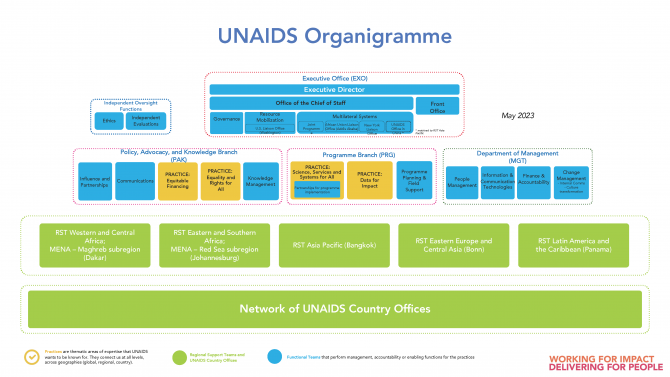
This year is a critical year for the AIDS response: it marks 40 years since the beginning of the AIDS epidemic, and a new Global AIDS Strategy 2021–2026 and a new United-Nations General Assembly Political Declaration on AIDS have been adopted.
To be in a strong position to support countries in implementing the new global AIDS strategy and achieving the targets set out in the Political Declaration on AIDS, UNAIDS embarked on an ambitious internal transformation across three workstreams—the realignment of the organization, the global AIDS strategy and a culture transformation for a safe, equal and empowering workplace.
New UNAIDS high-level organizational structure
On 12 July 2021, UNAIDS’ senior leadership endorsed a high-level organizational structure. On 23 November 2021, the Cabinet approved the staffing proposals for the new organizational structure.
The new structure presents a bold, knowledge-driven, networked Secretariat that builds on the organization’s unique added value while strengthening the areas of work that the Secretariat is already known for, such as communities and key populations, advocacy and human rights, gender equality and strategic information. The new structure elevates emerging issues, such as sustainable financing for HIV, health and pandemics. The new structure strengthens the organization’s function as the Secretariat of the Joint Programme on HIV/AIDS. It allows for better collaboration with cosponsors, ensures UNAIDS is closer to the needs of people living with and affected by HIV and better equipped to deliver on its mandate. The implementation of the new organizational structure started in mid-2022 and was carried out in a phased manner.
DOWNLOAD ORGANIGRAMME (Last updated May 2023)
A two-branch structure is introduced to align the Secretariat to deliver efficiently on the core structural and programmatic drivers of HIV and the underpinning inequalities. The two branches work at global, regional and country levels. The branches are:
- Policy, Advocacy and Knowledge Branch - enabling policy, law, and fiscal environments to support the goal of ending AIDS. It will focus on communications and influencing, gender, human rights, community, law and policy reform, and sustainable financing.
- Programme Support Branch - ensuring program and health services are at sufficient scale and quality to end AIDS. It will focus on services for all including HIV treatment, prevention, Strategic Information and HIV science.
Four global thematic practice areas are introduced that will drive the work of the Secretariat at the global, regional and country levels. The practice areas are:
- Data for impact
- Equality and rights for all
- Equitable financing
- Science, services and systems for all.
Critical global functions are decentralized and moved to regional hubs, while a smaller presence will be retained in Geneva. Staff with global functions and expertise are embedded in country and regional offices.
The Secretariat will move to a knowledge-based and networked organization that utilizes a knowledge management infrastructure to harness the collective knowledge across the Secretariat, Cosponsors and partners through communities of practice, knowledge hubs, networked teams and matrix management.
The new structure builds on UNAIDS’ role as a pioneer of UN reform by strengthening the Joint Programme coordination function and building closer collaboration with the Resident Coordinator system in strategic locations.
The new structure responds to the financial realities and future funding landscape enabling the Secretariat to withstand, and continue to operate, in the presence of fluctuating financial commitments. This has been done through strategic decentralization, relocation of positions and functions to lower-cost regions and enhancing the use of national capacities and staff.
Staff engagement was at the core of the Alignment process and the new structure was developed through a wide consultation process. Over the course of the Alignment 32 listening sessions were held in which approximately 500 staff members took part. A total of 286 staff responded to the all-staff survey on the alignment, 25 focus group discussions were convened in which 445 staff participated. Team cascaded meetings were held across the organization.
A working group comprised of members of the Senior Leadership Team (SLT) and two non-SLT members reviewed the data gathered in the staff consultations and after extensive deliberations arrived at a proposal for the structure of the organization. Following some amendments to the proposal, Cabinet endorsed the final structure on 12 July 2021.
Staff were further consulted during the co-creation of the staffing proposals. The co-creation phase was led by select members of the Cabinet, SLT and a designated staff member. Cabinet made its final decision on the staffing profiles on 23 November 2021.
The alignment exercise has moved at pace in order to minimize staff concerns. The process began in January 2021, initial decisions on the high-level organizational structure were announced in July 2021, and the staffing decisions in November 2021. The implementation is expected to take place, in a phased manner, beginning in July 2022.
The new structure represents a 10% reduction in UNAIDS staffing overall which will be implemented over time including through harmonisation of the size of country offices, progressive nationalisation of international positions in countries and delocalisation of Geneva offices. Changes are being made across all grades and categories of staff.
Every effort is being made to support staff who are impacted by the Alignment, this includes extensive training and career management support services and an expanded staff counselling function.

